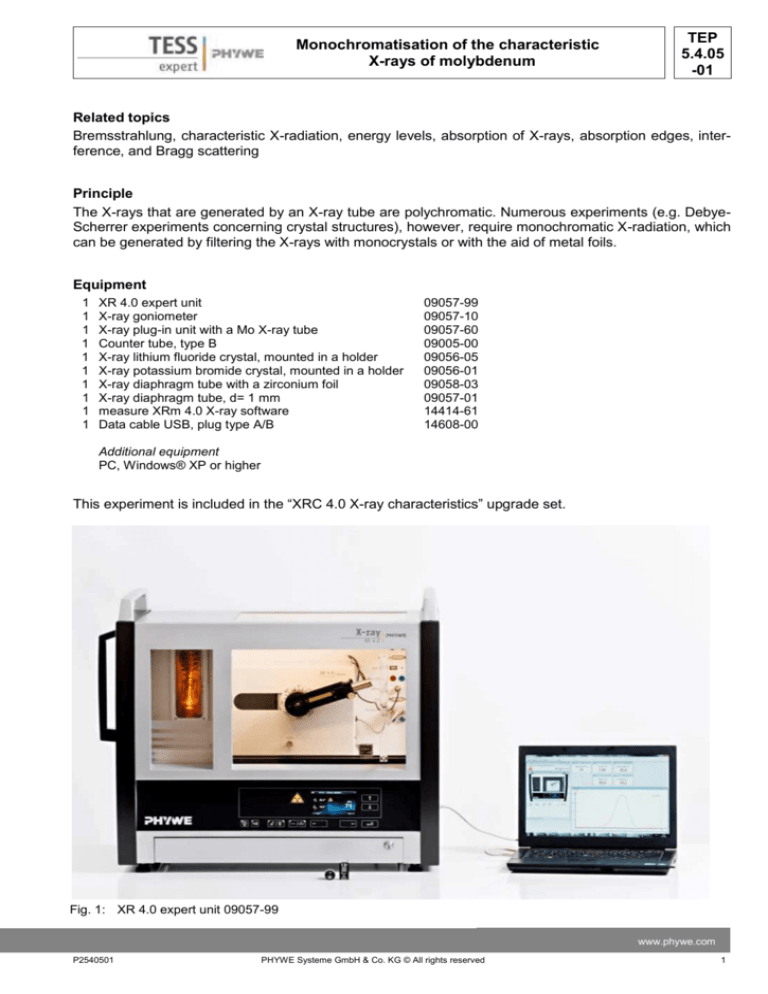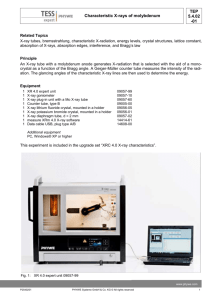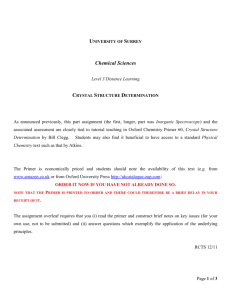
Monochromatisation of the characteristic
X-rays of molybdenum
TEP
5.4.05
-01
Related topics
Bremsstrahlung, characteristic X-radiation, energy levels, absorption of X-rays, absorption edges, interference, and Bragg scattering
Principle
The X-rays that are generated by an X-ray tube are polychromatic. Numerous experiments (e.g. DebyeScherrer experiments concerning crystal structures), however, require monochromatic X-radiation, which
can be generated by filtering the X-rays with monocrystals or with the aid of metal foils.
Equipment
1
1
1
1
1
1
1
1
1
1
XR 4.0 expert unit
X-ray goniometer
X-ray plug-in unit with a Mo X-ray tube
Counter tube, type B
X-ray lithium fluoride crystal, mounted in a holder
X-ray potassium bromide crystal, mounted in a holder
X-ray diaphragm tube with a zirconium foil
X-ray diaphragm tube, d= 1 mm
measure XRm 4.0 X-ray software
Data cable USB, plug type A/B
09057-99
09057-10
09057-60
09005-00
09056-05
09056-01
09058-03
09057-01
14414-61
14608-00
Additional equipment
PC, Windows® XP or higher
This experiment is included in the “XRC 4.0 X-ray characteristics” upgrade set.
Fig. 1: XR 4.0 expert unit 09057-99
www.phywe.com
P2540501
PHYWE Systeme GmbH & Co. KG © All rights reserved
1
TEP
5.4.05
-01
Monochromatisation of the characteristic
X-rays of molybdenum
Tasks
1. Analyse the intensity of the X-radiation of molybdenum as a function of the Bragg angle and with the
aid of LiF and KBr monocrystals. Determine the energy of the characteristic X-ray lines.
2. Use the LiF monocrystal to filter a characteristic line out of the polychromatic spectrum.
3. Monochromatise the X-ray spectrum with the aid of the zirconium foil.
Set-up
Connect the goniometer and the Geiger-Müller counter tube to
their respective sockets in the experiment chamber (see the red
markings in Fig. 2). The goniometer block with the analyser crystal should be located at the end position on the right-hand side.
Fasten the Geiger-Müller counter tube with its holder to the back
stop of the guide rails. Do not forget to install the diaphragm in
front
of
the
counter
tube
(see
Fig.
3).
Insert a diaphragm tube with a diameter of 1 mm into the beam
outlet of the tube plug-in unit for the collimation of the X-ray beam.
For calibration: Make sure, that the correct crystal is entered in
the goniometer parameters. Then, select “Menu”, “Goniometer”,
“Autocalibration”. The device now determines the optimal positions of the crystal and the goniometer to each other and then the
positions of the peaks.
Fig. 2: Connectors in the experiment
chamber
GMcounter
tube
Goniometer at
the end position
Diaphragm
tube
Counter tube
diaphragm
Mounted
crystal
Fig. 3: Set-up of the goniometer
2
PHYWE Systeme GmbH & Co. KG © All rights reserved
P2540501
TEP
5.4.05
-01
Monochromatisation of the characteristic
X-rays of molybdenum
Note
Details concerning the operation of the X-ray unit
and goniometer as well as information on how to
handle the monocrystals can be found in the respective operating instructions.
Procedure
- Connect the X-ray unit via USB cable to the
USB port of your computer (the correct port of
Fig. 4: Connection of the computer
the X-ray unit is marked in Fig. 4).
- Start the “measure” program. A virtual X-ray unit
will be displayed on the screen (Fig. 5).
- You can control the X-ray unit by clicking the
various features on and under the virtual X-ray
unit. Alternatively, you can also change the parameters at the real X-ray unit. The program will
automatically adopt the settings.
- Click the experiment chamber to change the parameters for the experiment.
- If you click the X-ray tube, you can change the
voltage and current of the X-ray tube. Select the
parameters as shown in Figure 6.
- Start the measurement by clicking the red circle
For setting the
For setting the
goniometer
X-ray tube
-
After the measurement, the following window
appears:
Fig. 5: Part of the user interface of the software
Select the first item and confirm by clicking OK. The measured values will now be transferred directly
to the “measure” software.
Overview of the goniometer and X-ray unit setAt the end of this manual, you will find a brief
tings for task 1:
introduction to the evaluation of the resulting
- 2:1 coupling mode
spectra.
- Gate time 2 s; angle step width 0.1°
- Scanning range 3°-65° (LiF monocrystal)
and 3°-75°(KBr monocrystal)
Note
- Never expose the Geiger-Müller counter tube
- Anode voltage UA = 35 kV; anode current
to the primary X-radiation for an extended peIA = 1 mA
riod of time.
-
Task 1: Analysis of the X-ray spectrum with LiF and KBr monocrystals
- Select the parameters as shown in Figure 7 for the LiF crystal. If you use the KBr crystal, select a
www.phywe.com
P2540501
PHYWE Systeme GmbH & Co. KG © All rights reserved
3
TEP
5.4.05
-01
Monochromatisation of the characteristic
X-rays of molybdenum
Fig 8: Goniometer settings; task 2
Fig 6: Voltage and current settings
start angle of 3° and a stop angle of 75° for the
scanning range.
Task 2: Monochromatisation with the aid of monocrystals
If only a narrow range of the polychromatic spectrum (e.g. the characteristic Kα line) is required, the goniometer settings must be changed as follows: The analyser crystal is set to its glancing angle position ϑ
= 10.3° (n = 1) in a fixed manner. The Geiger-Müller detector turns around the analyser crystal, e.g.
around
the
following
scanning
range:
start
angle
10° < 2ϑ < stop angle 30°. The corresponding goniometer settings can be found in Figure 8.
Task 3: Monochromatisation with the aid of filters
The procedure for this task corresponds to the procedure for task 1. In this case, however, the diaphragm tube (1 mm) must be replaced with the zirconium filter.
Theory
The X-rays that are generated by an X-ray tube are polychromatic. Lines whose energies are not dependent on the anode voltage but on the anode material are superimposed on the bremsspectrum (see
experiment P2540201). Since some experiments (Debye-Scherrer experiments concerning crystal structures) require monochromatic X-radiation, this radiation is generated by filtration with monocrystals or
with the aid of metal foils.
When X-rays of the wavelength λ impinge on the lattice planes of a monocrystal under the glancing angle ϑ, the rays that are reflected on the lattice planes interfere with each other in a constructive manner
provided that their path difference corresponds to an integral multiple of the wavelength. This situation is
explained by Bragg’s law:
2d sin n
(1)
(d = interplanar spacing; n = 1, 2, 3, …)
If the interplanar spacing d is known and if the glancing angle ϑ is determined, the energy E of the cor-
4
PHYWE Systeme GmbH & Co. KG © All rights reserved
P2540501
TEP
5.4.05
-01
Monochromatisation of the characteristic
X-rays of molybdenum
responding radiation can be calculated by using the following relationship:
E
nhc
2d sin
Planck's constant
Velocity of light
Interplanar spacing LiF (200)
Interplanar spacing KBr (200)
Equivalent
(2)
h
c
d
d
1 eV
= 6.6256∙10-34 Js
= 2.9979∙108 m/s
= 2.014∙10-10 m
= 3.290∙10-10 m
= 1.6021∙10-19 J
Evaluation
In the following section, the evaluation of the data is described based on example results. Your results
may differ from the results given below.
Task 1: Analysis of the X-ray spectrum with LiF and
KBr monocrystals
Figure 9 shows the intensity of X-ray spectrum of molybdenum as a function of the glancing angle ϑ, with
the LiF crystal used as the analyser.
(ϑ = 10.4°. n=1);
(ϑ = 20.9°. n=2);
(ϑ = 32.2°. n=3);
(ϑ = 9.2°. n=1);
(ϑ = 18.5°. n=2);
(ϑ = 28.4°. n=3);
EKα
EKα
EKα
EKβ
EKβ
EKβ
= 17.100 keV
= 17.244 keV
= 17.324 keV
= 19.525 keV
= 19.401 keV
= 19.399 keV
Fig. 9: X-ray spectrum of molybdenum with a LiF crystal as the analyser
The table shows the energy values for the characteristic X-ray lines that result from the glancing angles
ϑ of the characteristic lines in Figure 9 and from the interplanar spacing d = 201.4 pm of the analyser
crystal in accordance with (2) (see also P2540201).
www.phywe.com
P2540501
PHYWE Systeme GmbH & Co. KG © All rights reserved
5
TEP
5.4.05
-01
Monochromatisation of the characteristic
X-rays of molybdenum
Task 2: Monochromatisation with the aid of monocrystals
Figure 10 shows that only around an angle of 2 ϑ =
20.6° X-rays leave the analyser crystal.
Task 3: Monochromatisation with the aid of absorption foils
If a thin metal foil of the thickness x is brought into
the path of an X-ray beam of the energy E and intensity I0, the intensity behind the foil is as follows
due to absorption:
I E , x I 0 e E x
(3)
(μ [cm-1] = linear absorption coefficient)
Fig. 10: Monochromatisation of molybdenum X-radiation
with the aid of a monocrystal; filtered wavelength: λKα
Although the absorption coefficient is dependent
on the energy, it generally shows no dramatic change within an energy interval of several keV.
This changes dramatically, however, when the energy of the X-ray quanta is sufficiently high to eject
electrons from the lower energy levels of the atoms of the absorber material. In such a case, the absorption course shows a so-called absorption edge.
Zirconium (atomic number Z = 42), for example, is able to absorb the energy of the characteristic Kβ line
of molybdenum (atomic number Z = 42) nearly completely, because the energy of the K level of zirconium is slightly smaller than the energy of the Kβ line. The energy of the characteristic Kα line of molybdenum, on the other hand, is too small for ionising zirconium on the K shell. As a result, the intensity of
the Kα line is reduced only slightly by the zirconium filter in accordance with (3).
(EK (Zr) = 17.997 keV; Mo-EKα = 17.427 keV; Mo-EKβ =19.590 keV)
Figure 11 shows the result of the analysis of the X-ray spectrum of molybdenum with a zirconium filter
and a LiF monocrystal as the analyser. A comparison with the corresponding unfiltered spectrum (Fig. 9)
Fig 11: X-ray spectrum of molybdenum with a zirconium filter and a LiF crystal as the analyser
6
PHYWE Systeme GmbH & Co. KG © All rights reserved
P2540501
Monochromatisation of the characteristic
X-rays of molybdenum
TEP
5.4.05
-01
shows a considerable intensity reduction of the Kβ line of molybdenum, whereas the intensity of the Kα
line of molybdenum has been hardly reduced by the thin foil at all.
By approximation, the intensity of a spectral line is proportional to the intensity maximum of the line.
Based on this approximation, the comparison of both spectra (for n = 1) shows that the intensity of the
Mo-Kβ line has been reduced by approximately 60% by the zirconium filter (thickness d = 0.005 mm).
If a KBr monocrystal is used as the analyser, the results are the same (Figs. 12 and 13).
Fig. 12: X-ray spectrum of molybdenum with a KBr crystal as the analyser
Fig. 13: X-ray spectrum of molybdenum with a zirconium Kβ filter and a KBr crystal as the analyser
www.phywe.com
P2540501
PHYWE Systeme GmbH & Co. KG © All rights reserved
7
TEP
5.4.05
-01
Monochromatisation of the characteristic
X-rays of molybdenum
“measure” software
With the “measure” software, the peaks in the spectrum can be determined rather easily:
-
-
-
Click the button
nation.
and select the area for the peak determi-
Refer to the Help of the
“measure” software for additional, more detailed explanations concerning the program
features.
Click the button
“Peak analysis”.
The window “Peak analysis” appears (see Fig. 14).
Then, click “Calculate”.
If not all of the desired peaks (or too many of them) are calculated, readjust the error tolerance accordingly.
Select “Visualise results” in order to display the peak data directly in the spectrum.
Fig. 14: Automatic peak analysis with "measure"
8
PHYWE Systeme GmbH & Co. KG © All rights reserved
P2540501







